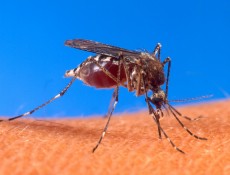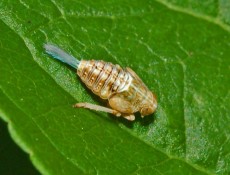Halloween Costumes for the Scientifically Minded
By Sara Knight
BU News Service
1. The Pegomastax Africanus (“thick jaw of Africa”), or the Vampire-Porcupine-Chicken-Dinosaur

This is an ideal costume for the archaeology aficionado. Based off paleontologist Paul Sereno’s serendipitous rediscovery of this little cat-sized terror’s fossils in a Harvard basement last year, your costume should encompass the main features of the cute little dinosaur:
– Parrot-like beak
– Giant fangs (its 3-inch skull boasted ½-inch long fangs)
– Coat of porcupine-like bristles (you can use straws cut to a point – bonus points if you can figure out a way to get them to stand-up as a reaction to threats)

The creature, which skittered about the Lesotho region of Africa 200 million years ago, was bi-pedal and had grasping hands; to recreate the posture I recommend the standard “raptor” stance – arms tucked in, back hunched, head tilted.
2.Genetically-modified Mosquito with Scientist, a costume for couples

If you come with a built-in Halloween partner like a significant other or friendly roommate, you may want to look into couple’s costumes. One possibility is to nod to the increasingly trendy method of stamping out tropical disease – that of releasing genetically modified mosquitoes into the wild. The flies are engineered by British biotech company Oxitec.
The male mosquitoes (which do not bite – you can blame all your itchy aggravations on the ladies) are engineered with a tragic flaw. They pass down an altered version of the tTA gene to their offspring that effectively prevents the larva from developing into full-grown adult mosquitoes, thereby diminishing the population density of these insidious vectors for dengue fever and malaria.
To pull off this costume, one party needs the standard “scientist” accessories – a lab coat, beaker, glasses – while the other needs a good fly costume complete with wings, bubble eyes, and probiscus. Bonus points if you incorporate some indicator of genetic modification – maybe a big red “NO” cross on your crotch?
3. The Steampunk Insect, or the Issus Bug

This little guy, scientific name Issus coleoptratus, was big news in September when a paper published in Science demonstrated it as the first example of a functional gear found in nature.
The nymph form of this plant-hopper insect has two interlocking gears at the top of their hind legs that serve as propulsion mechanisms, assisting the bug in its extreme jumping acrobatics. The adolescent Issus can reach jumping speeds of 8 mph and an acceleration rate of 400 g’s – a typical human can only tolerate up to 5 g’s.

To get this look, wear your best bug costume and attach cardboard gears to your hips.
4. The Higgs Boson, or the Hardest Halloween Costume EVER:
Scientists Peter Higgs and Francois Englert won the Nobel Prize for physics this week for their work developing the concept of the Higgs boson particle, which theoretically is responsible for providing all the matter in the Universe with mass.
The closest we can probably come to representing the Higgs boson in a Halloween costume would be to recreate the read-out from a simulated collision between two protons (picture below) touted as possible evidence of its existence:

To get this effect, attach LED light strands to a black turtleneck. Be ready to have to explain yourself constantly, understand esoteric physics, and most likely endure exasperated eye rolls from your fellow revelers.
Leave a Reply